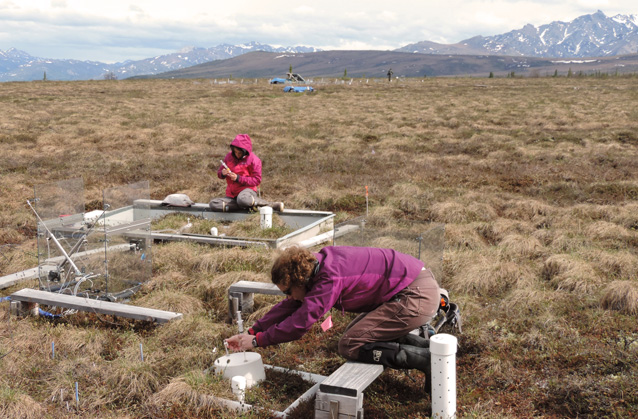
Photo Courtesy of John Schade
“I thought it was supposed to be flat,” one of Dr. John Schade’s undergraduate students called out as she struggled to navigate the hummocks and sedge tussocks that dominate the tundra landscape just outside Denali National Park and Preserve. As the group of students and their professor-mentor hiked over the uneven ground, the students raised questions about the vegetation and processes creating the lumpy topography that characterizes these tundra landscapes.
Schade arranged for four of his students to travel to the Denali area from St. Olaf College in southern Minnesota in the summer of 2013. The goal was to provide his students with hands-on research experiences. Their practical field time focused on two questions: How is the permafrost soil, which underlies the tussock tundra, changing as the Earth warms? How is the thawing of tundra soils affecting the production of greenhouse gases, specifically methane?
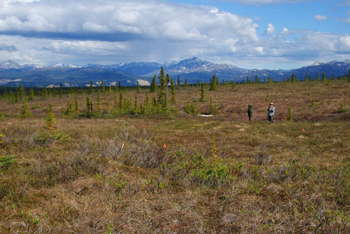
Photo Courtesy of John Schade
Permafrost and Carbon Storage
Permafrost soils are one of the great carbon storage zones on Earth, where, over millennia, the organic remains of plants and animals were frozen before they could be decomposed by microorganisms. Now that permafrost is thawing, these frozen remains will begin to decompose, returning long-stored carbon (C) to the atmosphere in the form of greenhouses gases such as carbon dioxide (CO2) and methane (CH4).
Methane Release from Tundra Soils
When frozen soils thaw, and conditions become more favorable to microorganisms, soil organic matter decomposes. Gases, including methane, are products of this decay. Methane is produced most commonly when oxygen is not available. These anaerobic conditions often are found in water-logged soils because oxygen in the atmosphere does not diffuse through water very quickly.
Scientists have focused much of their attention on the potential for CH4 production from wetlands and lakes, while CH4 emission from drier upland tundra generally has been assumed to be insignificant. Tundra, however, covers a huge area in the Arctic, so even a small amount of CH4 production could be important when considered on a landscape scale.
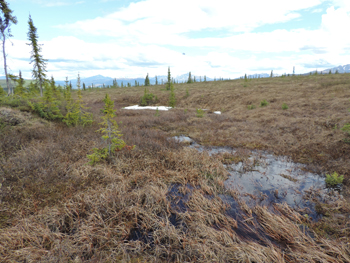
Photo Courtesy of John Schade
Changing Tundra and Thermokarst
Perhaps the most obvious change in the warming tundra landscape, as ice-rich permafrost thaws, is the collapse or subsidence of the ground surface. The uneven surface characterized by sunken ground and wet hollows is known as thermokarst. Thermokarst can increase the area of water-logged soils, which may become sites of significant CH4 production.
The little hills and valleys over which the students stumbled to get to their study site, were, in part, the result of changes to the foundation of permafrost that lies beneath.
One of the reasons that Schade selected methane gas as a research focus is this greenhouse gas is ~25 times more efficient at trapping heat in the atmosphere than is carbon dioxide. The production of methane greatly influences and accelerates climate change. Thus, a better understanding of where and how it is formed is critical for projecting the impact of thawing permafrost on climate change.
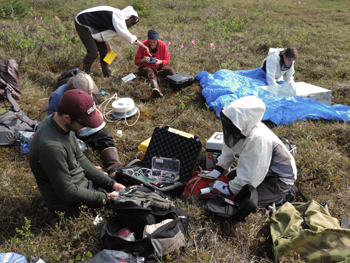
Photo Courtesy of John Schade
Coordination with the CiPEHR Experiment
Several years ago, two Arctic ecologists, Sue Natali of the Woods Hole Research Center, and Ted Schuur of the University of Florida, set up a large-scale experiment to investigate what the impacts of climate change on permafrost are likely to be. The project is known as the Carbon in Permafrost Experimental Heating Research (CiPEHR) and occupies part of the tundra along the Stampede Road corridor near Eight Mile Lake north of the park.
These scientists selected an area as a control. They did not modify this area, but the ambient conditions seem to represent the tundra’s response to a warming climate (i.e., subsidence and water-logged soils). They also designed an innovative way to create two experimental conditions: (1) they warmed soil (in winter by erecting snow fences to capture blowing snow and increase the insulating snow depth, and in summer with no-lid clear boxes), and (2) they dried soils using a system of pumps. Their goal was to tease apart the influences of changes in soil temperature and soil moisture on gas emissions from tundra soils.
Field Methods
In June 2013, Schade and his students were able to sample methane production in the two experimental areas, in which the tundra soils had been warmed artificially, or warmed and dried, and in the control area. Because the students were able to be present only in June, they arranged to have the other scientists collect samples for them in September.
In both June and September, the students/scientists capped the soils with large plastic chambers (see the white disk in photo at left). The chambers trapped any gases, including methane, being released at the surface of the tundra. The researchers removed air samples, via sample ports, when the chamber was first placed on the soil and after the chamber had been in place for 10, 20, and 30 minutes. They took gas samples from 18 plots (six in each experimental or control area). Later, the students analyzed all the samples for methane using a gas chromatograph. By calculating how quickly methane accumulated in the chamber, they could determine the rates of methane release from the soils.
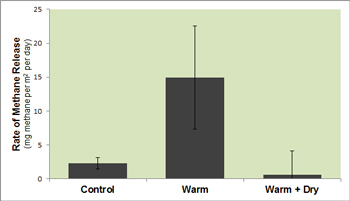
Findings and Implications
Schade’s data, gathered and analyzed with the assistance of students, clearly document that tussock tundra soils are producing CH4 primarily in September when thaw depth above the permafrost is maximum for the year. In September (see bar graph at right), the methane released from the warmed tundra soils was 10 times what was produced by the tundra under current “natural” conditions and also was 10 times what has been reported as average methane production of “dry tundra” by other researchers working in northern permafrost environments. The rate of CH4 emission from the warmed and dried soils was slightly lower than the rate where the soils had not been modified, but the difference was not significant.
If a warming climate warms tundra globally, then the outcome likely is widespread permafrost thaw and waterlogged soils, which are subject to the increased CH4 emission that Schade and his students measured. In this scenario, tundra would become a major contributor to CH4 flux from northern ecosystems. Global models now underestimate the impact of northern latitude warming on future climate change by not including the potential impact of future methane production from tussock tundra.
Schade’s students did more than successfully navigate bumpy tundra. They documented what permafrost thaw may mean for methane release and the influence of soil moisture on rates of CH4 emission. Methane emissions could add significantly to the “pool” of greenhouse gases, and thus could greatly accelerate climate change in the future.
Last updated: April 21, 2016
